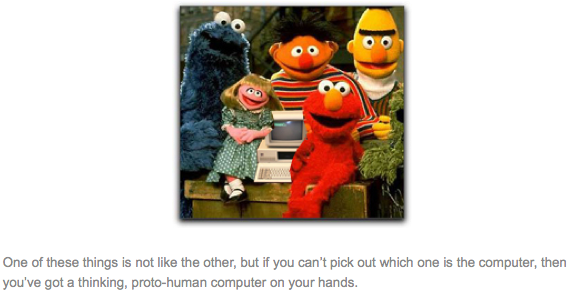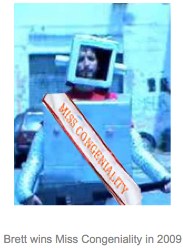It's been a while since I've done one of these posts. Not that I haven't thought about what it means to be a writer every second of every minute of every day. It's an occupational hazard. However, this most recent revelation is just too defining to writerdom not to share.
You might be a writer if...you still carry a security blanket.
Don't get me wrong. We're not that obvious about it. We're writers. We've given them much better names, such as Mac, Notebook Pro, Laptop, or the classic, best disguise, Computer.
As if, you sneer.
It's my computer.
That's all.I see. Let's run a little checklist, shall we?
1) Is "your computer" one of the last things you look at before you go to bed? And one of the first when you get up?
2) Do you lovingly clean its parts?
3) Do you start to feel nervous when you haven't spent time with "your computer"?
4) So do you take it with you everywhere you go?
5) Take it out of the car when it's cold or hot, just like a child?
6) Is it your ONE carry on, regardless?
7) Does your heart skip a beat when, say, your husband/child/insert name of person who clearly does not get how IMPORTANT this "computer" is accidentally unplugs your "computer" and the battery runs down and it won't fire up right away?
8) Do you plot revenge?
9) When there's a tornado, earthquake (we've had our share here in Oklahoma this fine fall) or other possible natural disaster, do you have an exit strategy that includes all essentials, such as your children, your husband, the pets, and your "computer"?
10) Most importantly, does it feel like an organic extension of you?
If you've answered yes to three or more of these questions, you may want to sit down. I have news. Your computer isn't just a computer. It's a security blanket.
That's not a bag thing. I mean, our livelihoods depend on these computers, don't they? We find creative expression - and, if we're really lucky, a paycheck - through its magical electrical circuits (Is that a good story idea?) It's no wonder we carry them with us wherever we go.
What was telling for me is that I didn't always feel this way about my computer. The joined-at-the-hip feeling started somewhere in the middle of my dissertation, i.e. my first official written creation. When I was six months pregnant with my first child (actual, human child), I was knee deep in the dissertation. I had six of eight chapters almost complete. I got up, went through my usual morning routine, then sat down at my computer. I opened the dissertation file, which I had backed up on two different external drives, and in individual chapters just to make sure I didn't lose anything. Stories of other grads who'd lost whole dissertations due to lazy back up methods were more than urban myths in grad schools. They were nightmares.
One that became real for me. None of the files would open.
Panic. Major, major panic. The kind that was so intense my daughter didn't move for six hours.
To make a long, painful story somewhat less painful for those of you who can imagine what it's like to lose 40,000 well-crafted words, complete with illustrations, I ended up at the computer lab at UVA. Many techs later, I was at the IT guru's desk, the last resort, the nuclear option of technical difficulties. He tried everything. Nothing worked. Then he made a call. A friend of a friend had an experimental version of the latest Word program. There were no promises but...
In that moment, I understood Faust only too well.
I went to the
Pistoletto show at the Serpentine Gallery but found it rather disappointing and banal. In an attempt to take something positive from the show, I took a photo on my iPhone of my head reflected in one of the mirrors and processed it heavily to make this picture.
Apps used: PS Express, PhotoForge, Photostudio and DXP. Click to enlarge.
 Spot the hidden word.
Spot the hidden word.
Click to enlarge.

So, you think you want to be a writer?
It doesn't matter if you devote 24/7 to the writing life or work another job and squeeze in writing time when possible. You still need basic necessities that make writing an easier task.
First, you need a space. Virginia Wolff believed a woman needs a room of her own. And, she's right. A writer needs an office/spot at the dining room table/a booth at the local coffee shop that she can call her own. Granted, some places provide better work opportunities than others, but a writer needs a space to set up shop. When I started freelancing, I converted a former bedroom into my cramped office, but I made it comfortable by repainting the walls to a cheery tangerine, adding memorabilia that inspires me, and using the space for writing only. What is your ideal office set-up?
Second, you need supplies. Even though you'll submit the majority of your work online, you still need to stock up on basics, like envelopes, paper, and stamps. I also make sure I have plenty of ink cartridges on hand, as well as Post-It notes, notebooks, batteries, postage (it's a 17-mile trip to town) and pens. I keep a separate notebook in my office, kitchen, bedroom and car. You never know when inspiration will strike! If you will be conducting interviews on a regular basis, invest in a digital audio recorder. It's a time saver! What office supplies do you have available?
Third, you need a computer and accessories. When I began freelancing, I didn't have the latest, greatest computer. I had a five-year-old laptop that was slow as molasses. But, I could still produce articles and stories. After a couple successful (translate: lucrative) sales, I upgraded to a computer that fit my needs. This included a photo software program, since photos must accompany most articles I write, as well as digital movie making software, since more online publications are asking me for a video to accompany a story package. But you can't just think about what computer you need. Think internet connection and make sure it's reliable. You also need to consider a printer, camera, digital video recorder, and scanner, depending on what you write. What type of computer essentials do you rely on most?
Fourth, you need a phone. Plus, it needs to be reliable. Nothing is more frustrating than being in the middle of an interview while on a cell phone and the network cuts out! We do not have a landline in our home, so I rely on my Blackberry to connect with contacts. With its myriad features, I use it to schedule appointments, network, send Twitter updates, and even type a story if I am on deadline. Do you use a land line, cell phone, or both to connect with your contacts?
<
































Psst...Bradbury. Or Slaughterhouse Six.